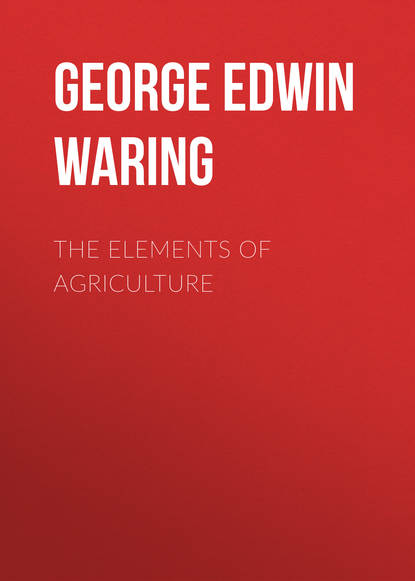По всем вопросам обращайтесь на: info@litportal.ru
(©) 2003-2024.
✖
The Elements of Agriculture
Настройки чтения
Размер шрифта
Высота строк
Поля
How does lime prepare the constituents of the soil for use?
What can you say of the remark that lime exhausts the organic matter in the soil?
By its action on the roots, buried stubble, and other organic matter in the soil, it causes them to be decomposed, and to give up many of their gaseous and inorganic constituents for the use of roots. In this manner the organic matter is prepared for use more rapidly than would be the case, if there were no lime present to hasten its decomposition.
By the decomposing action of lime on the mineral parts of the soil (3), they also are placed more rapidly in a useful condition than would be the case, if their preparation depended on the slow action of atmospheric influences.
Thus, we see that lime, aside from its use directly as food for plants, exerts a beneficial influence on both the organic and inorganic parts of the soil.
5. Many contend that lime exhausts the soil.
If we examine the manner in which it does so, we shall see that this is no argument against its use.
How can lime exhaust the mineral parts of the soil?
Must the matter taken away be returned to the soil?
It exhausts the organic parts of the soil, by decomposing them, and resolving them into the gases and minerals of which they are composed. If the soil do not contain a sufficient quantity of absorbent matter, such as clay or charcoal, the gases arising from the organic matter are liable to escape; but when there is a sufficient amount of these substances present (as there always should be), these gases are all retained until required by the roots of plants. Hence, although the organic matter of manure and vegetable substances may be altered in form, by the use of lime, it can escape (except in very poor soils) only as it is taken up by roots to feed the crop, and such exhaustion is certainly profitable; still, in order that the fertility of the soil may be maintained, enough of organic manure should be applied, to make up for the amount taken from the soil by the crop, after liberation for its use by the action of the lime. This will be but a small proportion of the organic matter contained in the crop, as it obtains the larger part from the atmosphere.
The only way in which lime can exhaust the inorganic part of the soil is, by altering its condition, so that plants can use it more readily. That is, it exposes it for solution in water. We have seen that fertilizing matter cannot be leached out of a good soil, in any material quantity, but can only be carried down to a depth of about thirty-four inches. Hence, we see that there can be no loss in this direction; and, as inorganic matter cannot evaporate from the soil, the only way in which it can escape is through the structure of plants.
If this course be pursued, will the soil suffer from the use of lime?
Is it the lime, or its crop, that exhausts the soil?
Is lime containing magnesia better than pure lime?
What is the best kind of lime?
If lime is applied to the soil, and increases the amount of crops grown by furnishing a larger supply of inorganic matter, of course, the removal of inorganic substances from the soil will be more rapid than when only a small amount of crop is grown, and the soil will be sooner exhausted—not by the lime, but by the plants. In order to make up for this exhaustion, it is necessary that a sufficient amount of inorganic matter be supplied to compensate for the increased quantity taken away by plants.
Thus we see, that it is hardly fair to accuse the lime of exhausting the soil, when it only improves its character, and increases the amount of its yield. It is the crop that takes away the fertility of the soil (the same as would be the case if no lime were used, only faster as the crop is larger), and in all judicious cultivation, this loss will be fully compensated by the application of manures, thereby preventing the exhaustion of the soil.
Is the purchase of marl to be recommended?
How is lime prepared for use? (Note.)
Describe the burning and slaking of lime.
Kind of lime to be used. The first consideration in procuring lime for manuring land, is to select that which contains but little, if any magnesia. Nearly all stone lime contains more or less of this, but some kinds contain more than others. When magnesia is applied to the soil, in too large quantities, it is positively injurious to plants, and great care is necessary in making selection. As a general rule, it may be stated, that the best plastering lime makes the best manure. Such kinds only should be used as are known from experiment not to be injurious.
Shell lime is undoubtedly the best of all, for it contains no magnesia, and it does contain a small quantity of phosphate of lime. In the vicinity of the sea-coast, and near the lines of railroads, oyster shells, clam shells, etc., can be cheaply procured. These may be prepared for use in the same manner as stone lime.[31 - Marl is earth containing lime, but its use is not to be recommended in this country, except where it can be obtained at little cost, as the expenses of carting the earth would often be more than the value of the lime.]
The preparation of the lime is done by first burning and then slaking, or by putting it directly on the land, in an unslaked condition, after its having been burned. Shells are sometimes ground, and used without burning; this is hardly advisable, as they cannot be made so fine as by burning and slaking. As was stated in the first section of this book, lime usually exists in nature, in the form of carbonate of lime, as limestone, chalk, or marble (being lime and carbonic acid combined), and when this is burned, the carbonic acid is thrown off, leaving the lime in a pure or caustic form. This is called burned lime, quick-lime, lime shells, hot lime, etc. If the proper quantity of water be poured on it, it is immediately taken up by the lime, which falls into a dry powder, called slaked lime. If quick-lime were left exposed to the weather, it would absorb moisture from the atmosphere, and become what is termed air slaked.
What is air slaking?
If slaked lime be exposed to the air, what change does it undergo?
What is the object of slaking lime?
How much carbonic acid is contained in a ton of carbonate of lime?
How much lime does a ton of slaked lime contain?
What is the most economical form for transportation?
When slaked lime (consisting of lime and water) is exposed to the atmosphere, it absorbs carbonic acid, and becomes carbonate of lime again; but it is now in the form of a very fine powder, and is much more useful than when in the stone.
If quick-lime is applied directly to the soil, it absorbs first moisture, and then carbonic acid, becoming finally a powdered carbonate of lime.
One ton of carbonate of lime contains 11¼ cwt. of lime; the remainder is carbonic acid. One ton of slaked lime contains about 15 cwt. of lime; the remainder is water.
Hence we see that lime should be burned, and not slaked, before being transported, as it would be unprofitable to transport the large quantity of carbonic acid and water contained in carbonate of lime and slaked lime. The quick-lime may be slaked, and carbonated after reaching its destination, either before or after being applied to the land.
What is the best form for immediate action on the inorganic matter in the soil?
For most other purposes?
As has been before stated, much is gained by slaking lime with salt water, thus imitating the lime and salt mixture. Indeed in many cases, it will be found profitable to use all lime in this way. Where a direct action on the inorganic matters contained in the soil is desired, it may be well to apply the lime directly in the form of quick-lime; but, where the decomposition of the vegetable and animal constituents of the soil is desired, the correction of sourness, or the supplying of lime to the crop, the mixture with salt would be advisable.
The amount of lime required by plants is, as was before observed, usually small compared with the whole amount contained in the soil; still it is not unimportant.
[AH] The straw producing the grain and the turnip and potato tops contain more lime than the grain and roots.
What is the best guide concerning the quantity of lime to be applied?
What is said of the sinking of lime in the soil?
What is plaster of Paris composed of?
Why is it called plaster of Paris?
The amount of lime required at each application, and the frequency of those applications, must depend on the chemical and mechanical condition of the soil. No exact rule can be given, but probably the custom of each district—regulated by long experience—is the best guide.
Lime sinks in the soil; and therefore, when used alone, should always be applied as a top dressing to be carried into the soil by rains. The tendency of lime to settle is so great that, when cutting drains, it may often be observed in a whitish streak on the top of the subsoil. After heavy doses of lime have been given to the soil, and have settled so as to have apparently ceased from their action, they may be brought up and mixed with the soil by deeper plowing.
Lime should never be mixed with animal manures, unless in compost with muck, or some other good absorbent, as it is liable to cause the escape of their ammonia.
PLASTER OF PARIS
Plaster of Paris or Gypsum (sulphate of lime) is composed of sulphuric acid and lime in combination. It is called 'plaster of Paris,' because it constitutes the rock underlying the city of Paris.
Is it a constituent of plants?
What else does it furnish them?
How does it affect manure?






